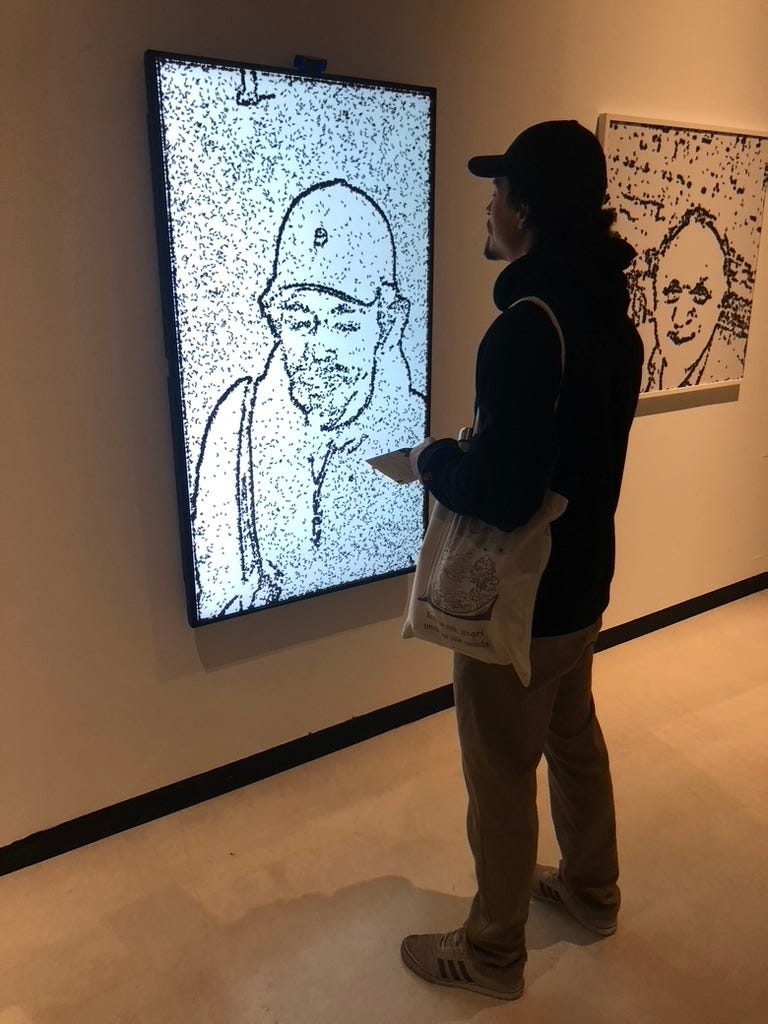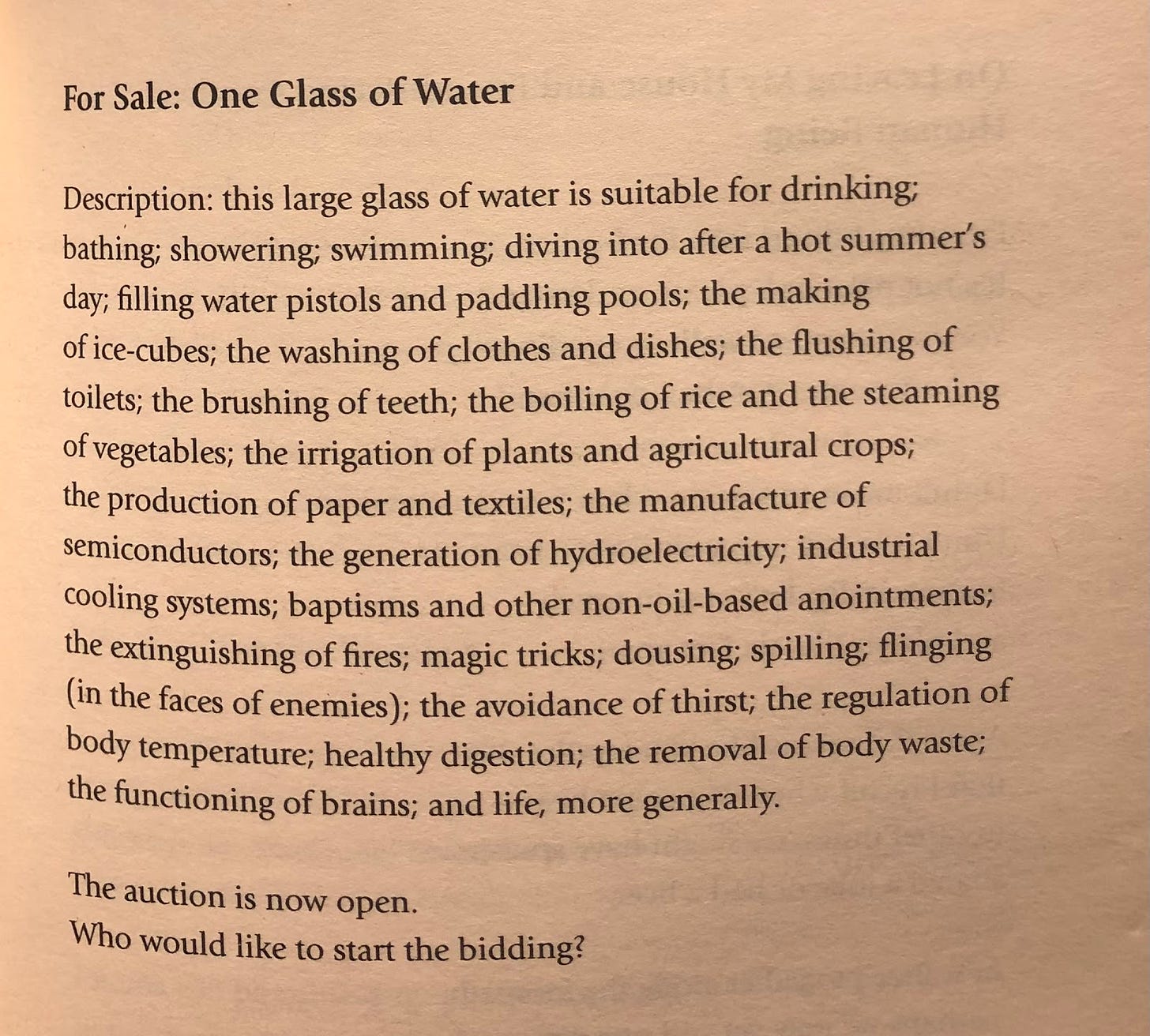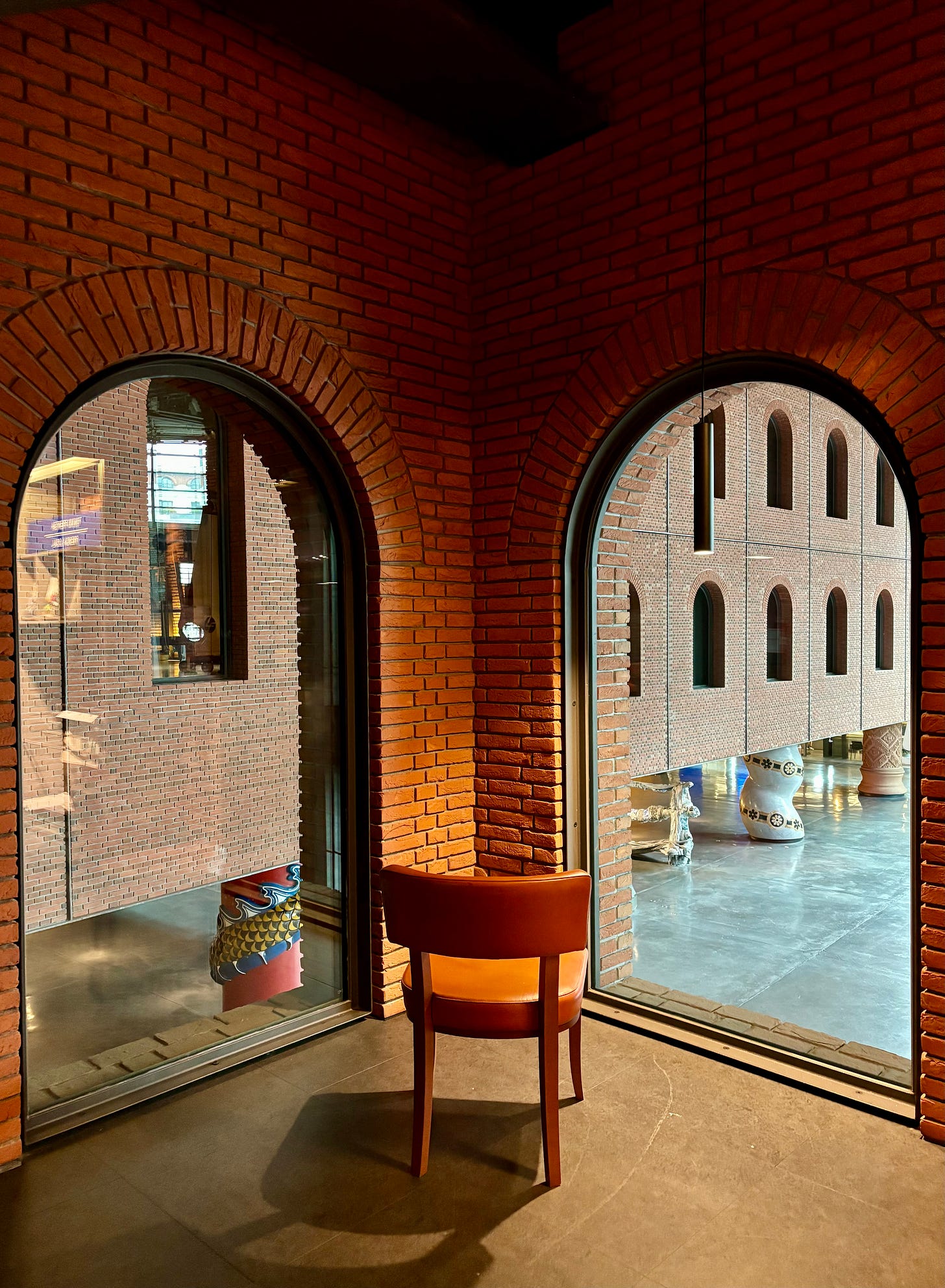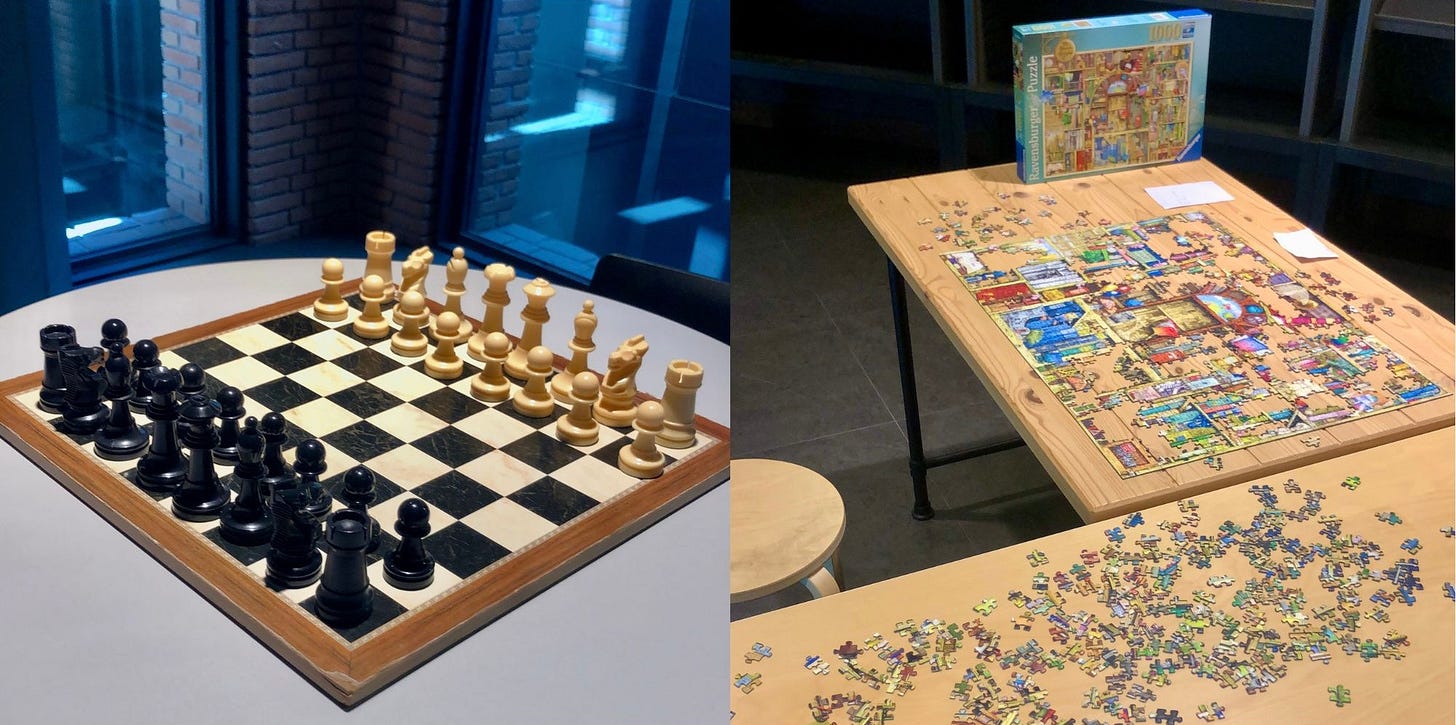All-Inclusive Stay at the Azkuna Zentroa
Activity, creativity, and community awaits at Bilbao's former wine warehouse, current cultural event center — the Azkuna Zentroa. And of course, reflections on travel.
This is the second part of a three-part, three-cities-in-one-week trip I took in March during Catholic Holy Week, a full-week holiday in Spain. To get the whole trajectory, read the first part here — Making the Most out of a 10-Hour Layover in Mallorca.
Part Two
Saturday, March 23, 2024, cont’d
The final flight
After a long, eventful, and spontaneous day during my 10-hour layover in Palma de Mallorca, I finally arrived to my second destination: Bilbao.
From the Bilbao airport, I take the 3-euro bus to the city center and thankfully don’t have to wait too long to board, excited and eager to finally see my partner again. I can’t help but smile like a crazy person walking to Alex’s workplace from the bus station. Long distance is difficult but the excitement to see each other every chance we get is electrifying.
I’ve walked the same route through town before, and it feels good not having to depend (much) on Google Maps. I recognize the markers that tell me I’m headed in the right direction. I revel at the level of cool I feel knowing my way around a place I’ve never lived in. I finally reach Bilbao’s huge Modernist-style cultural center, the last landmark telling me I’m somewhere around the corner. Reaching the restaurant Alex works at, I peak in through the window to not distract him from his managerial duties. He comes out with a bag of food for me and a huge smile on his face.
Realizations while savoring the fresh flavors of vegetarian ceviche
The last few days have felt very present. It could’ve been because I have a full week off work, I’m going to be spending time with my partner, and I’m finally going to solo-travel again.
I’ve had a fascination with Bilbao for a couple years. It’s a predominantly liberal city with evident subcultures, complex history, nearby beaches, and lush hilly views. A characteristic combination that screams my name.
When applying to NALCAP, an English TA-like program in Spain, I was asked for my top three regional preferences to live and work in. I put the Basque Country as my first preference, and filled out the rest in accordance to whatever could place me in Bilbao — choosing urban as opposed to rural, and population in the hundred-thousands as opposed to tens of thousands.
In the end, I didn’t receive any of my preferences. I had to choose between several regions with leftover spots, and Basque Country’s neighbor, Cantabria, became my new home.
Interesting how things worked out though. On my first visit to Bilbao that year, I chatted up a cute bartender at a restaurant my friends and I got drinks at. Now, he’s MY cute bartender (in a cute and fun and spoiled kinda way).

Sunday, March 24, 2024
What’s left to explore? Actual public spaces.
Usually, when people travel somewhere new for the first time, the priority is to check off the tourist sites, the must-sees and must-eats recommended by TripAdvisor or the Lonely Planet or whichever travel guide/agency that brings a twinkle to their eyes. And it makes sense! If we’re in a new place for a short amount of time, might as well check out the best of the best. How could someone visit Paris once in their life and skip the Eiffel Tower or the Mona Lisa? Impossible. But prove me wrong, I’d love to hear from someone who opted out!
Fortunately, I’ve been able to tick off some of the most dire Bilbao to-do’s— visiting the Guggenheim Museum, Puppy, Old Town, Cathedral, Plaza Nueva. I’ve also managed to take an architecture tour along the river, make friends with the resident peacock at Parque de Doña Casilda, walk up the 323 stairs to the Basilica de Begoña, dance at BBK Live music festival.
When over-focused on deeply researched checklists, we often forget the hidden places city dwellers actually inhabit. The places that create community in a city often have nothing to do with the itineraries we praise.
The next morning, my partner drops me off at the library in the Azkuna Zentroa-Alhóndiga Bilbao before he heads to work (restaurant workers unfortunately do not get Holy Week off). Formerly a wine warehouse, this hyphenated title refers to Bilbao’s cool, industrial, multipurpose cultural center.
QUICK CHAT ABOUT EUSKERA, BASQUE COUNTRY’S REGIONAL LANGUAGE
‘Azkuna Zentroa’ is in Euskera, Basque Country’s regional language. Euskera is said by linguists to be the oldest living language in Europe, one that’s completely different from Spanish, mysterious for belonging to it’s own family with no other language like it in the world. Throughout the 20th century, Euskera and Basque culture were repressed and punished during Francisco Franco’s dictatorship in Spain. Now, people in the Basque Country have taken back their culture and language, many Basque people even wanting to separate from Spain. In Bilbao, Basque Country’s capital city, you’ll see lots of Euskera, but you may hear more Spanish. As you branch out in surrounding towns and villages, Euskera takes over. Public school subjects are taught in Euskera, and most public jobs require fluency in the language. In that way, they’re able to maintain the tradition of the region.
Cultural centers and libraries are such underrated places that can tell us a lot about a place and the ways it creates community. Not only is the Azkuna Zentroa home to a three-floor library, but a top-floor balcony for bird’s-eye city views, changing art installations, an Exhibition Hall displaying a variety of free art exhibits every few months, a movie theater, a physical activity center (not free 😢), and more!
In the library, I’m immediately fascinated by the dark industrial interior — rust-orange brick walls, black ceilings, visible pipes, spotlights shining on the colorful spines of the shelved books.
I’m drawn to a section of poetry books near the entrance, and start skimming one that creatively reflects on each day of the year and what it celebrates. Today, March 24th, is World Meteorological Day.
More importantly, I check to see if the book includes last Friday’s World Water Day, and alas, it does.
QUICK CHAT ABOUT WATER AND SPAIN’S STRIKING VARIETY
If you read part one of the Semana Santa trilogy, you already know about Southern Spain’s Málaga, the drought, and the water-saving social marketing campaign the government designed to motivate and help citizens control their water usage.
Málaga winters are mild and sunny, hardly a day of clouds, let alone rain. Although there’s a drought in Málaga, leading to measures like fining people for filling up their pools, Northern Spain’s Bilbao is far from that problem. My partner describes the temperature as ‘bipolar’ because in one instant it could be sunny and inspiring but minutes later it can be pouring rain and depressing. Bilbao winters are exclusively rain-ridden, and free, clean water is accessible at various public water fountains throughout the city all year long.
Often times, traveling within a nation can feel like traveling outside of it.
It feels good to be at a new library, unbound by time. To have no responsibilities other than experience a city I’ve already experienced, but in a way deeper than and less pressured than before. I don’t feel the need to be ‘productive’ by sightseeing or by advancing my job hunt, MA hunt, or whatever opportunity hunt I’m giving myself anxiety about that day. Letting myself and my curiosity just be is being productive because it’s fulfilling.
(¡)DUH(!) I’m reflecting on the Travel reads!
My eyes continue grazing the bookshelves for amusing skims. What grabs my attention immediately is a high-contrast photograph of a yellow tent in front of a snow-capped mountain before a cloudy night sky. The dark yet bright magazine cover intrigues me but the title sells me — Nomadikt.
I flip to an article with a blown up photograph of a mountain biker doing a front wheel lift on top of a roofed structure along the Great Wall of China. Unfortunately, that first impression is slightly disappointing.
I’m aware that walking the Great Wall of China is a common trek. Supposedly, many people bike the Great Wall of China, too. I can’t help but beg the question: How is someone allowed to bike on THE ROOF OF A STRUCTURE from BCE-built architecture? I guess the government is okay with it? But are the people? From what I understand, he biked along a part of the wall that’s ‘rarely visited’ by tourists. Is it rarely visited for a reason? The Great Wall of China was constructed thousands of years ago… How does biking and bunnyhopping along the dome of a historical structure impact that formation’s conservation? What do you think about this? Am I missing something here?
I can’t help but think about the many Maya archaeological sites I got to visit when studying abroad in the Yucatán Peninsula. Many of the sites don’t permit tourists to even walk up the structures’ steps. I’m forced to imagine a skateboarder going up the stairs of the temple of Uxmal, doing an ollie, and using the side as a ramp — this image is shocking and disturbing to even come up with! Having learned about Maya language, culture, and history during that time had created an empathetic attachment to Maya history, which may be what makes that disrespect especially painful to imagine. It could also be what rings my alarm when I see or read about personal adventures that impact the conservation of history and heritage. But do we need an attachment to a place to understand the line between conscious travel and disrespect?
Sometimes we feel called to reach a certain objective, no matter the cost. It’s hard not to empathize with the dedication and persistence in reaching a long-time (travel) goal. However, sometimes it costs us nothing to make personal sacrifices for the good of the whole, which in this case would be promoting archaeological conservation while preventing the negative impact and poor reputation tourism (and especially adventure tourism) can have on local communities and culture. Sounds like that personal sacrifice could have pretty valuable results.
I think it’s important to be conscious of the ways we can create harm to local communities and cultures when we travel. Ideally, we should minimize our impact as much as possible. When we leave a destination, our footprints should be so faint that they’re hardly recognizable, encouraging locals to thrive both with and without tourism.
After all this reflection and contemplation, the PA system announces that the library is closing in 15 minutes. Deciding I’ll come back another day to explore the remaining levels of the literary cave, I quickly flip through the rest of the mag to see what other thought-provoking stories I can scan.

Mother-Son Duo Bikes Latin America
The next interview changes my entire demeanor from contemplative to elated. It’s an interview with Tania Hope and Toti, a mother and 11-year-old-son duo who biked from Mexico City to Ushuaia, Argentina. They rode over 20,000 kilometers through nine countries for 480 days. Tania was rewarding her son’s good work at school with his dream to see penguins in Patagonia as the final goal.
This stirring story is one that inspires me to keep prioritizing travel, keep putting myself outside my comfort zone, and keep believing I can do the impossible. I’m grateful to have access to and be exposed to so many people who dream big, live big, and do so mindfully! Stories like this get me wondering what my mind would look like if I flushed out each conventional piece of influence that has nothing to do with the life I want to live.
The library closes at 2 PM, but considering it’s Sunday, I’m surprised it’s open at all. In Málaga, libraries are closed the whole weekend and usually the world shuts down on Sundays in Spain (except for restaurants and cafés, of course). Regardless, I could’ve spent all day at that intellectual haven.
Tuesday, March 25, 2024
Another Day, Another Activity at the Azkuna Zentroa
The workweek has started, meaning longer hours of operation (woot woot!). I take the elevator up to the top floor of the massive building to check out the balcony for the first time. There’s a vast empty space covered by wooden floors, like a huge swimming pool deck. And there’s actually a pool on the floor, too! But contrary to what one may hope, the pool is indoors and only for paying members. What a drag! (But if it was an outdoor pool I would’ve been more jealous.)
Loitering on the balcony, I can’t help but take photos of the unique architecture the sun exhibits so gracefully. Suddenly, the clouds envelope the sun… “that’s enough for now,” they say.
I go back to the ‘Medioteka’ aka library and explore the rest of it’s floors like I promised myself. The first floor, which I was chilling on yesterday, even had a whole art gallery in the back that I didn’t notice yesterday! On the second floor, there’s a whole room dedicated just to comic books and online animation resources (“Komikteka”), and the third floor is all about leisure, with chess and puzzles just laying out and about for whoever to work on or play. I’m in love with the idea of putting together a puzzle with a bunch of strangers at random points in the day or week — your team member might be someone you glance across throughout the day as they eat a tortilla next door with their mid-day wine, or as they hang on the monkey bars at the playground a block over, or as they sell you freshly harvested artichokes and mandarins at your local produce shop (called ‘fruterías’).

When my partner gets off work, I meet up with him in the building’s basement to check out the FREE art exposition — The Artwork as a Living System.
The interactive exhibit exposes the relationships between digital art and nature. As we roam the room, we’re encouraged to experience the installations through touch, watching as our physical interactions digitally change the artwork. The installations replicated ‘living systems,’ one example being the movement of flies and ants across a screen, adapting to the contour of movement and depth in front of them (photo above).
We eventually arrive at some hanging plant pots with a huge projected image of a digital garden. We’re told by one of the guards to touch the soil of the (real) plants and watch as the energy of our touch gets transmitted into a similar digital plant on the screen in front of us. The most hard-to-believe part is that this installation was created in 1992! At the end of the row of plants hangs a cactus, which holds the reset button. I dig my fingers in the soil waiting to see what happens, and indeed, the digital garden disappears, giving space for a new one to grow.
The potential is boundless!
The Art as a Living System exhibition is dependent on the people who interact with it, the Medioteka is dependent on the people who find use in its free resources and quiet study space, and the Azkuna Zentroa, among every other cultural center, is dependent on the community that connects with it. This leads me to ponder — is a city’s cultural center a representation of the community’s values, interests, and shared experiences? OR is a city’s cultural center what forms the community’s values, interests, and shared experiences?
Do you have a cultural center where you’re from? What does it mean to your community? I would love to hear about your experiences in the comments or in private!
What a fulfilling way to spend my free time, browsing bookshelves, roaming rooftops, admiring art, spending time with my love. Letting myself and my curiosity just be. Balancing my to-do’s with my to-be’s. A lot more occurred on this stop and I skip some days, but the Azkuna Zentroa was the main character in my alone time and deserved the limelight in this article. On the other hand, Alex was the limelight of my trip, but I’ll save my love for him for a different post.
Thanks to it all, this stop in Bilbao has left me feeling detoxed and inspired for the solo-trip to come.
Thank you for reading! Until part three.
With peace, love, and compassion,
Tea <3









Amazing piece, Tea!!